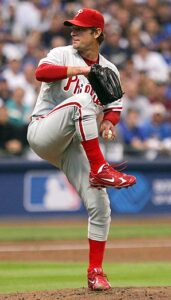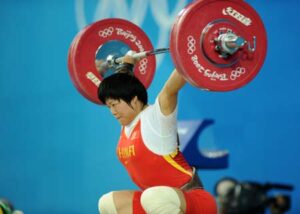Overbearing Dads and Kids Who Throw Cheddar
Q: I run into a TON of Fathers who want their son to gain throwing velocity. What are your keys to gaining velocity?
A: To be blunt, Step 1 is getting away from your crazy overbearing father and realizing that if you’re going to throw the baseball harder, it’s because YOU want to do it, and are willing to put in the hard work. There are millions of American fathers who want their sons to throw 95+mph, but only about eight guys in the big leagues who consistently throw that hard.
Taking it a step further, the average fastball velocity is actually higher in A-ball than it is in professional baseball, so while throwing hard is important, it’s just one piece of the puzzle. I’d love to hear more fathers talking about learning to command the fastball and master a change-up. And, most importantly, I’d like to see more fathers who are interested first and foremost in keeping their kids healthy so that they can have the continuity necessary to realize their potential.
Next, you have to consider what kind of velocity we’re actually discussing. Is it what the radar gun reads: actual velocity? That’s really just one of three kinds of velocity.
You also have perceived velocity – which is higher in a pitcher who gets down the mound further than his counterparts and therefore gives the hitter less time to react. Chris Young (at 6-11) gets the benefit of perceived velocity in spite of the fact that his average fastball velocity doesn’t even approach 90mph.
Perceived velocity also explains the success of many pitchers with deceptive deliveries where the ball seems to just jump up on hitters. Often, these pitchers stay closed and throw across their bodies. While it may not be healthy, correcting it could take away their effectiveness.
Lastly, back in 2008, Perry Husband introduced me to the concept of effective velocity, which is a bit more complex. The effective velocity a hitter appreciates is actually impacted by:
1. pitch location (high and inside are faster, and low and away are slower)
2. previous pitch location, type, and velocity (coming up and in with a fastball makes it seem harder if it follows a low and away change-up)
3. the count (when behind in the count, the hitter must cover a larger strikezone, and therefore a larger effective velocity range)
If you need any proof of the value of effective velocity, just watch Jamie Moyer or Tom Glavine. They nibble away over and over again, and then they come back inside on a guy and he looks blown away by the velocity even though it may only be low-80s.

That said, getting down to the nuts and bolts of throwing the ball hard (actual velocity) mandates that you understand that there are tons of factors that contribute to velocity, but they aren’t the same for everyone. Very simply, there isn’t just one mechanical model that allows one to throw harder than others.
Some guys have congenital laxity that allows them to contort their bodies all over the place. Others “muscle up” and shotput the ball to the plate. Most pitchers are somewhere in the middle and rely on a balance of elastic energy and mobility to make things happy. With that in mind, having mechanical efficiency and thousands of perfect throwing reps in this efficient model is what every pitcher should strive to achieve – just as a golfer would practice his swing or an Olympic lifter would practice the clean and jerk or snatch.

Second, it’s imperative to prepare young pitchers’ bodies for the rigors of throwing a baseball. I’ve written extensively about the overwhelming extremes the throwing arm faces, and while it’s important to improve arm strength, flexibility, and soft tissue quality, the rest of the body cannot be ignored. Improving function of the scapular stabilizers, core musculature, and lower half is essential for taking stress of the throwing arm. We encourage kids to get started with foam rolling, targeted flexibility work, and resistance training as soon as their attention span allows. As I have written previously, the “stunting growth” argument doesn’t hold water.
Third (and this piggybacks on my last point about resistance training), it’s important to understand how to manage a young pitcher throughout the year. Contrary to popular belief, playing year-round is not a good idea. In fact, it isn’t even good enough to qualify as a “bad” idea; it is an atrocious idea.
If you want my ideal competitive season for a youth baseball player, it’s to pick up a ball and start tossing around Thanksgiving, progressing to bullpen wok in early January after long-tossing distance has been progressed. Then, the athlete throws up through his competitive high school season (late March- early June) and summer ball (through early August). That’s about 8-8.5 months of throwing throughout the course of the year – and it’s plenty.
You’ll see that this competitive year fits quite nicely with participation in a fall sport – whether it’s football, soccer, or something else. And, athletes can still “get away” with playing winter sports as long as they’re willing to commit to a throwing program, even if they have to start playing a bit late. If I had to give my ideal scenario, I’d say play football or soccer, and then play pick-up/intramural basketball in the winter alongside a throwing and lifting program.
Within this year, you have several crucial blocks during which to increase resistance training volume. One, there is the entire winter break, obviously. Two, there is generally a decent break between spring and summer baseball (late May-early June), and another during the month of August. Three, kids can (and should) still train in-season, regardless of the sport.
This, of course, speaks to the high school athletes who have practice/games just about every day. Managing a 10-year-old is a lot easier. His sport practice may only be 2-3 days per week – meaning that he can participate in different activities throughout the week. However, he can’t do that if Dad thinks that playing on four different AAU teams at once is the secret to getting him to the big leagues. He has to play multiple sports at a young age.
So, if I had to give the synopsis of my thoughts on how to get a kid to throw hard, it would go something like this:
1. Appreciate that throwing hard is just one piece of the “being a successful pitcher” puzzle – and that there are different types of velocity (actual, perceived, and effective).
2. Clearly outline his competitive season and stick to that outline. Don’t add showcases, camps, and additional teams.
3. Let him play for two teams: one spring (school) and one summer (AAU, Legion, etc.).
4. Find a skilled pitching instructor to work with him to optimize mechanical efficiency. Before you start working with this instructor, have him explain his approach to managing your son both during a typical lesson and throughout the competitive season. Then, go and observe him as he works with other pitchers. Do they just “show and go,” or do they warm-up before even picking up a ball? Does he ask kids how they feel prior to each session, and does he pace them throughout the session? Or, does he just grunt and spit dip juice all over the place.
5. Get him involved in a comprehensive strength and conditioning program that incorporates resistance training, medicine ball work, flexibility training, and movement training that all take into account the unique demands of baseball. The strength and conditioning coach should provide a thorough evaluation that screens for all the mobility deficits and stability issues we commonly see in throwers.
6. Make sure that the pitching coach and strength and conditioning specialist communicate and collaborate. The CP staff is fortunate to have this kind of productive collaboration with Matt Blake all the time:
Kidding aside, very rarely will a pitching coach know about strength and conditioning, and very rarely will a strength and conditioning coach know about pitching. It’s unfortunate, but true.
7. Have him play multiple sports. The younger the pitcher, the more sports he should play. Specialization shouldn’t come until age 17 at the earliest.
8. Make sure he continues to take care of his resistance training and mobility work in-season.
I could go on and on about all the subtle details of what we do with pitchers on a daily basis, but the truth is that I envision this blog as something that will be most popular with the Dads in the crowd who really just want to help their kids realize their potential and remain injury-free. So, I’m keeping it more general – and referring you to the Baseball Content page for the more “geeky” stuff.
I do have one more closing thought, though. We deal with a lot of very talented young pitchers who throw the ball very hard. One anecdotal observation has been that their fathers are the ones who “get it.” These are the guys who are concerned about the important things: staying healthy, enjoying baseball, finding the right college, etc. They don’t boast about how many guys their sons struck out in little league. They are genuinely humble and respect the game – and this carries over to their kids, who work hard and carry themselves the right way.
Conversely, the kids who are always told that they’re the best and get raved about by their fathers are the ones who invariably struggle to succeed long-term. It may be because they’re overworked, over-pressured, or just overrated in the first place. It may be because coaches get frustrated with having to deal with an overbearing father, and the kid gets punished for it. It may be that the kid doesn’t think he needs to work as hard because he’s already the best – because Dad told him so. Or, maybe he misses out on crucial development because he spends all his time playing in baseball games when he should be practicing, training, or participating in other sports – or just having fun and being a normal kid. Worst of all, a kid may just flat-out start to dislike the game because all the fun has been taken out of it because of Dad’s hype and excessive pressure.
Is velocity important? Sure. Can it sometimes be the trees that prevent us from seeing the forest? Absolutely.
Sign-up Today for our FREE Baseball Newsletter and Receive a Copy of the Exact Stretches
used by Cressey Performance Pitchers after they Throw!






